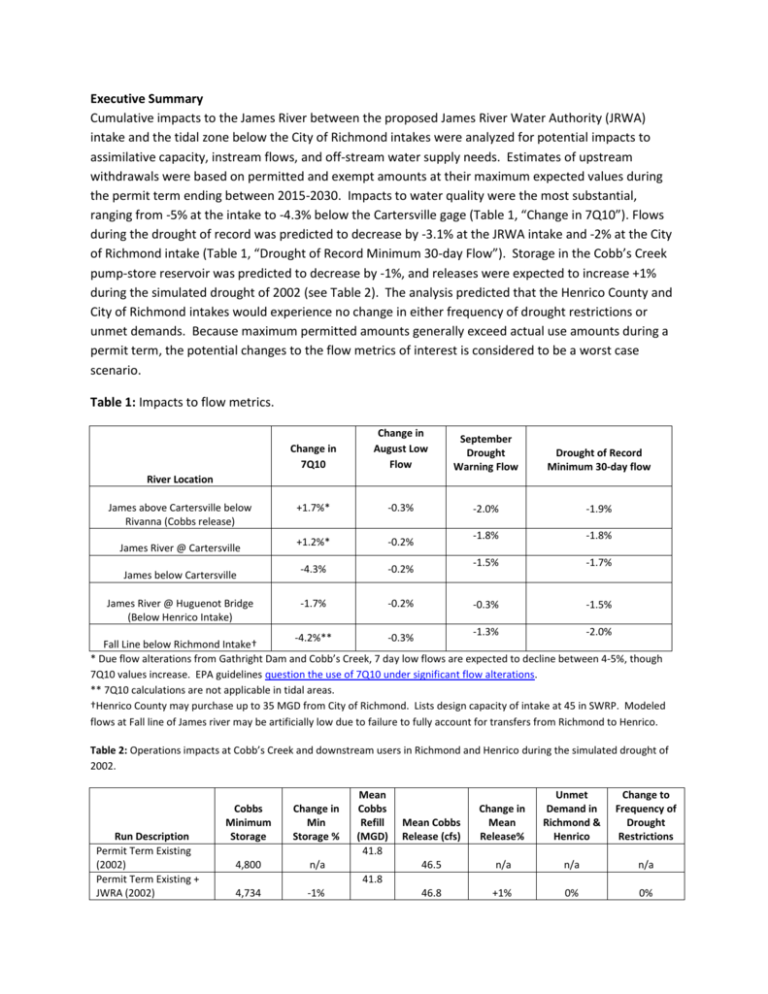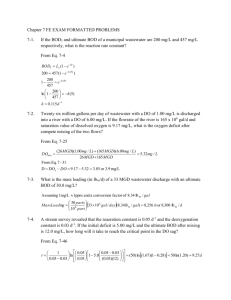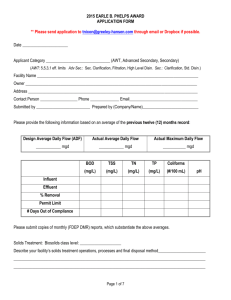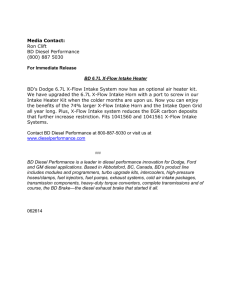Cia_analysis_v02
advertisement

Executive Summary Cumulative impacts to the James River between the proposed James River Water Authority (JRWA) intake and the tidal zone below the City of Richmond intakes were analyzed for potential impacts to assimilative capacity, instream flows, and off-stream water supply needs. Estimates of upstream withdrawals were based on permitted and exempt amounts at their maximum expected values during the permit term ending between 2015-2030. Impacts to water quality were the most substantial, ranging from -5% at the intake to -4.3% below the Cartersville gage (Table 1, “Change in 7Q10”). Flows during the drought of record was predicted to decrease by -3.1% at the JRWA intake and -2% at the City of Richmond intake (Table 1, “Drought of Record Minimum 30-day Flow”). Storage in the Cobb’s Creek pump-store reservoir was predicted to decrease by -1%, and releases were expected to increase +1% during the simulated drought of 2002 (see Table 2). The analysis predicted that the Henrico County and City of Richmond intakes would experience no change in either frequency of drought restrictions or unmet demands. Because maximum permitted amounts generally exceed actual use amounts during a permit term, the potential changes to the flow metrics of interest is considered to be a worst case scenario. Table 1: Impacts to flow metrics. Change in 7Q10 Change in August Low Flow September Drought Warning Flow Drought of Record Minimum 30-day flow +1.7%* -0.3% -2.0% -1.9% +1.2%* -0.2% -1.8% -1.8% -4.3% -0.2% -1.5% -1.7% -1.7% -0.2% -0.3% -1.5% River Location James above Cartersville below Rivanna (Cobbs release) James River @ Cartersville James below Cartersville James River @ Huguenot Bridge (Below Henrico Intake) -1.3% -2.0% -4.2%** -0.3% Fall Line below Richmond Intake† * Due flow alterations from Gathright Dam and Cobb’s Creek, 7 day low flows are expected to decline between 4-5%, though 7Q10 values increase. EPA guidelines question the use of 7Q10 under significant flow alterations. ** 7Q10 calculations are not applicable in tidal areas. †Henrico County may purchase up to 35 MGD from City of Richmond. Lists design capacity of intake at 45 in SWRP. Modeled flows at Fall line of James river may be artificially low due to failure to fully account for transfers from Richmond to Henrico. Table 2: Operations impacts at Cobb’s Creek and downstream users in Richmond and Henrico during the simulated drought of 2002. Run Description Permit Term Existing (2002) Permit Term Existing + JWRA (2002) Cobbs Minimum Storage Change in Min Storage % 4,800 n/a Mean Cobbs Refill (MGD) 41.8 Mean Cobbs Release (cfs) Change in Mean Release% Unmet Demand in Richmond & Henrico Change to Frequency of Drought Restrictions 46.5 n/a n/a n/a 46.8 +1% 0% 0% 41.8 4,734 -1% Modeling Details The JRWA intake was modeled using the VAHydro operational model. Intake flow-by was set at 90% of instantaneous flow at the intake location. This flow-by provided adequate water to satisfy the requested annual demand of 1507.92 MG (monthly variations in JRWA demands shown in Figure 3). The VAHydro model was run from 1984-2005 with demands set to the maximum allowable withdrawal for permitted users active during the proposed permit term 2015-2030. Table 3 shows a comparison between the demands in this simulation (“Permit Term Max 2015-2030”), present day demands (Table 3, “Current Demands”), and projected demands in the year 2040 (Table 3, “State Water Plan 2040”). Flow-by rules for Henrico and City of Richmond demands were modeled according to Army Corps of Engineers 401 certificate. In addition to flow-by rules, the systems were modeled with conservation reductions of 5%, 10% and 15% at Drought watch, warning and emergency conditions. As a result of these conservation reductions, the Permit Term Max withdrawal for the City of Richmond of 95 MGD amounted to 93.4 MGD in practice during 1984-2005 simulation period. Table 3: Withdrawal comparison between Current, VWP Permit term max, and State Water Resource Plan 2040 projected demands in the James River watershed above the Cobbs Creek intake. Location Above Cobb's Creek Intake James River At Fall Line Permit Term Max 2015-2030 311 MGD 451 MGD†† Current Demands (2009-2013) 220 MGD 317 MGD† % Difference Permit Max vs. Current +41% +42% State Water % Difference Plan Permit Max 2040 vs. SWP 281 MGD +11% 401 MGD +12% † Henrico 25.8 MGD Current, 75.2 MGD Permit max, 35 MGD may come from City of Richmond, resulting in only 45 MGD withdrawal from James at Henrico intake. †† City of Richmond increasing from 73 - 82 MGD in State Water Plan, with a Permit Max of 95 MGD . Demand (MGD) Figure 1: Monthly demand patterns simulated for JRWA intake. 5 4.5 4 3.5 3 2.5 2 1.5 1 0.5 0 1 2 3 4 5 6 7 8 Months (1.Jan- 12.Dec) 9 10 11 12 Figure 2: Modeled Percent change in September Drought Warning Flow (10th %) due to the proposed JRWA intake. Figure 3: Modeled Percent change in drought of record flow due to the proposed JRWA intake. Based on cumulative flow and withdrawal timeseries during September of 2002. Figure 4: Modeled Percent change in 7Q10 flow due to the proposed JRWA intake. Based on cumulative flow and withdrawal timeseries during from 1984-2005 meteorological and flow conditions. Figure 5: Modeled Percent change in August Low Flow flow due to the proposed JRWA intake. Based on cumulative flow and withdrawal timeseries during from 1984-2005 meteorological and flow conditions.







